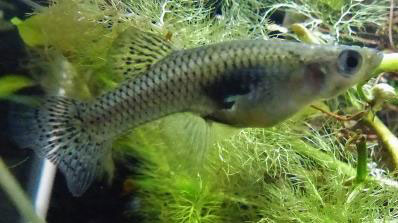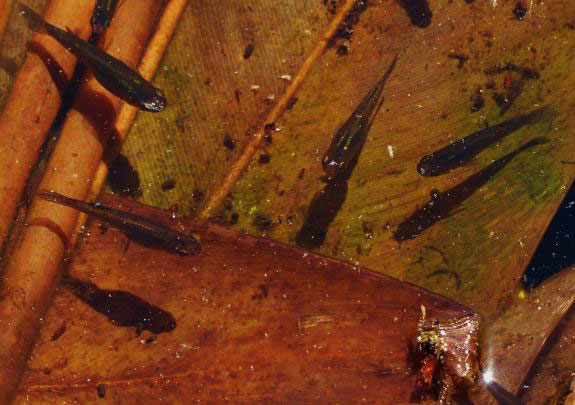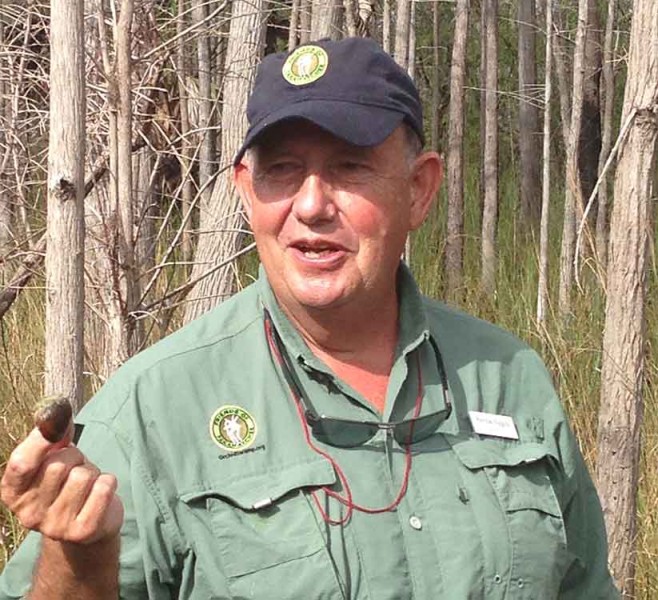by Patrick Higgins

A female Eastern Mosquito Fish (Gambusia holbrooki). Photo by Patrick Higgins.
I’m often privileged to take people into the Fakahatchee for their very first swamp walk. It’s nearly always a transformative experience for them. After marveling about the dappled light, oohing over the epiphytes, commenting on the clarity of the water, the fresh minty smell and how surprisingly firm the footing is, they often quizzically remark “but there are no bugs.” Well, that is if you take them to the right place at the right time of the year. And if the mosquito fish are dong their job.
By bugs of course they mean mosquitoes and so, on cue, I can launch into a talk about those little two-winged flies and their nemesis, the humble mosquito fish. As Floridians we can be very proud; we have over 80 species of mosquitoes. That’s more than any other state. These can be divided these into two broad groups; floodwater and standing water mosquitoes.
Floodwater mosquitoes, like our particularly vicious black salt marsh mosquito (Aedes taeniorhynchus), don’t lay their eggs in water. Instead they seek out moist ground. The eggs need to dry out before they hatch and lay dormant in mud cracks and crevices. When they are inundated by heavy rains, or in the upper reaches of our salt marshes, monthly by spring tides, they quickly develop. The density of mosquito eggs in a floodwater habitat can be staggering, as high as 1.3 million per acre.
All but 3 other species of our ‘swamp angels’ are standing water mosquitoes that lay their eggs in water. They cannot withstand drying out and usually hatch within 24 hours. Fortunately in both categories it’s only the females that need a blood meal as a protein source for egg development. The males typically feed on nectar. Think what it would be like otherwise.
In a perfect model mosquitoes should only be a problem at the beginning and end of the dry season when there are isolated pockets of water that our native mosquito fish cannot reach. But it’s not as simple as that, because sometimes the rains don’t follow our seasonal model. Last summer was a classic example. The rains started in a timely manner in June, but kind of stopped in July, then came back with a vengeance in September. I was reconnoitering a potential new swamp walk off South Main a few weeks after this occurred, and the mosquitoes were so bad I couldn’t escape soon enough.
We’d had repeated deluges that had flooded the dry swamp landscape, triggering floodwater eggs and creating habitat for standing water mosquitoes to breed. And breed they did at a much faster rate than their vertebrate predator, the mosquito fish. This created a lag, which if you plotted on graph paper would show a classic bell curve as the mosquito population surged, then a rapid decline as the mosquito fish population multiplied and spread across the newly created aquatic landscape. Eventually we reached a nice equilibrium for our swamp walk season.
So our unsung hero in all this is the Eastern Mosquito fish (Gambusia holbrooki). The females are about 2 ½ inches long, and the males are about an inch shorter. Gambusia are viviparous – they bear live young, which enhances their survival probability. In nature the quantity of offspring is usually inversely related to the chances of any individual reaching maturity and reproducing. So, for example, when a female cod spawns she lays hundreds of thousands of eggs. A mosquito fish typically only gives birth to 25 live young, but can do this up to nine times a season. These young reach sexual maturity in 4-6 weeks. They are technically planktivores, but are voracious predators of mosquito larvae when available. A large female can consume hundreds a day.
But here’s the rub, as demonstrated by a remark made to me on a recent tram tour – “We should get some of those and take them up to Michigan.” That’s exactly what has been done all over the world. The problem is that they have co-evolved here in a highly competitive environment where they’ve had to eke out a specialized niche. When they are introduced to non-native waters they tend to prey heavily on the eggs and young of other fish species – perhaps the very ones that ate mosquito larvae there. So if you search the literature on mosquito fish, you’ll find most of it is about how to get rid of them where they have been introduced.
Incidentally a British biotech firm is in the late stages of FDA approval for a trial release of genetically modified male Aedes aegypti mosquitoes here in Florida. The idea is to help control the spread of Zika and dengue fever. They have been engineered to pass on a ‘kill-switch’ gene when they mate with our wild females. This prevents their offspring reaching maturity. Trials in other countries have reduced the target Aedes population by more than 90 per cent, but I’m not sure the locals in Key Haven, the chosen test site, will go for it so we’ll just have to rely on our Gambusia.
Patrick Higgins is a National Association of Interpretation Certified Interpreter, Vice-President of the Friends of Fakahatchee and Project Manager for the development of the Boardwalk Master Interpretive Plan.


